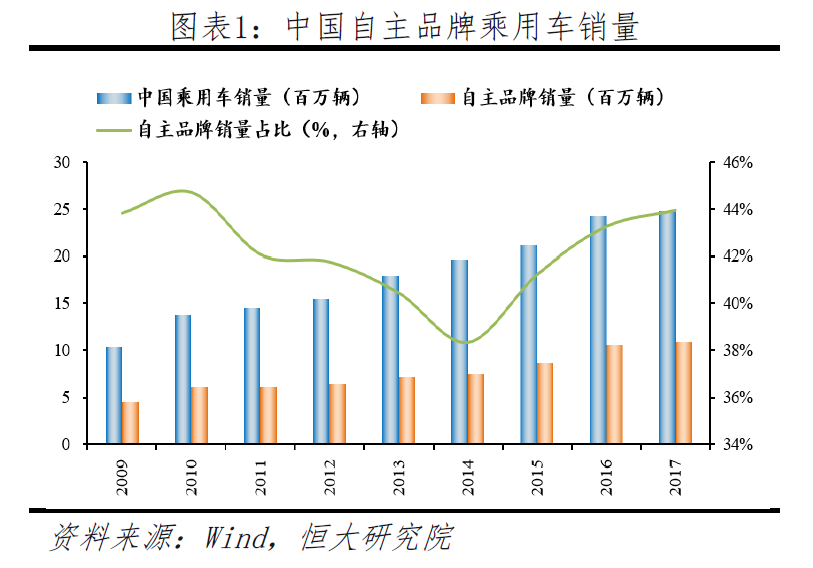Refined from Evergrande Research Institute "reflection on China's Automobile Industry Policy: why China's Automobile Industry is large but not strong?" "
1. Domestic sales of independent brands account for less than half, and are concentrated in the middle and low end of the market.
Of the nearly 100m global car sales in 2017, China accounted for 30 million, making it the world's largest car market.
But a big car country is not a great power. At present, the top sellers in China's automobile market are still joint venture brands such as SAIC-Volkswagen, SAIC-GM and FAW-Volkswagen. Independent brands account for less than half of the sales, and most of them are concentrated in the low-end market.

The proportion of domestic sales of independent brands has been hovering between 40% and 45%, and there is no substantial breakthrough.
From the perspective of market structure, the high-end domestic automobile market is still firmly occupied by joint venture brands and imported cars, and independent brands mostly survive in the gap between the middle and low end of the market. Take Geely, which ranks first in its own brand, as an example, the average price of a bike in 2017 was only 74000 yuan, less than half of the average price of Volkswagen and Toyota, and an even bigger gap compared with luxury cars such as Mercedes-Benz and BMW.
2. The joint venture is not suitable.
At the beginning of reform and opening up, under the huge technology gap with foreign countries, we chose the joint venture road of "market for technology".
According to the logic of "exchanging market for technology", the development path design of China's automobile industry is to introduce advanced product technology through joint ventures, then localization of parts and components, and finally realize independent development.

Due to the long-term policy protection, the joint venture can easily obtain monopoly profits, and all the internal subjects of the joint venture (Chinese managers, Chinese employees and foreign investors) have no incentive to carry out independent research and development.
However, as the joint venture has been protected by policy for a long time and can enjoy monopoly profits, the internal subjects of the joint venture have no motivation to carry out independent research and development, and are finally content with the status quo and gradually lose their competitiveness.

In terms of research and development, the R & D investment of the three major domestic car companies SAIC, FAW and Dongfeng has been insufficient for a long time, and the proportion of expenditure to revenue is basically between 1% and 2%, which is far lower than that of international mainstream car companies such as Toyota and Volkswagen (4%). 5%).
 3. Lack of effective and orderly opening mechanism and competition mechanism.
3. Lack of effective and orderly opening mechanism and competition mechanism.
Industrial policy sets an excessively high entry threshold for the industry.
In 1994, the State Council stipulated that the annual production of cars with engine displacement below 1600cc should not be less than 150000. At that time, Shanghai Santana, which has the largest automobile production scale in China, has an annual capacity of only 115000 vehicles, and the scale requirements of industrial policy actually set a very high obstacle for private enterprises that lack capital accumulation.
The reason for setting such a high threshold is that at that time, the automobile industry showed the characteristics of "small and scattered", and the automobile was an industry with significant economies of scale, so all small-scale production projects would intensify disorderly competition and bring repeated investment. it will not help to enhance the competitiveness of the industry. But in fact, there is no causal relationship between scale and benefit. Late entrants to the auto industry, both Geely and Chery, have made a profit by the time they have an annual production capacity of 20, 000 units, rather than 100000 of policy-making.
Lack of orderly opening mechanism
At the beginning of reform and opening up, the policy of restricting the proportion of FDI equity and levying high tariffs is for the protection of immature industries. There is no problem with these policies themselves, but there is a lack of a clear top-level design for the exit period of these policies. Under this condition of "soft constraint", the managers of automobile enterprises do not have enough sense of crisis and urgency.
In additionUnder the current multi-head management system, the coordination of industrial policy is more difficult.Under the current management system of the automobile industry, the Ministry of Industry and Information Technology undertakes the responsibilities of automobile industry management, policy formulation, the formulation of access conditions, the development of major technology and equipment, and the planning of independent innovation. The NDRC has retained the responsibilities of major automobile construction projects and the examination of foreign investment, but SASAC is responsible for the assessment of joint venture automobile enterprises (mostly state-owned enterprises).
